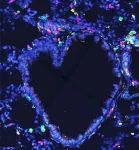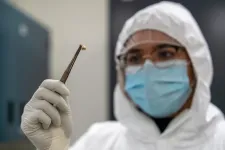(Press-News.org)
Philadelphia, February 24, 2023—Researchers at Children’s Hospital of Philadelphia (CHOP) have identified variants of a chaperone molecule that optimizes the binding and presentation of foreign antigens across the human population, which could open the door to numerous applications where robust presentation to the immune system is important, including cell therapy and immunization. The findings were published today in Science Advances.
Class I major histocompatibility complex (MHC-I) proteins are found on the surface of cells from all jawed vertebrates and play an essential role in the immune system. The MHC-I displays peptide fragments of proteins from within the cell on the cell surface, effectively “presenting” them to the immune system, which is constantly scanning the body for foreign or toxic antigens. When foreign peptides are identified, they trigger a cascade that allows cytotoxic T cells to eliminate intruders.
For a peptide to be presented to the immune system, it needs to be loaded on a folded MHC-I protein. Several molecules facilitate this process, including proteins known as molecular chaperones, which assist with MHC-I folding. Tapasin and a similar molecule known as TAPBPR are both molecular chaperones that facilitate MHC-I folding and peptide loading. Because TAPBR functions independently outside of the peptide-loading complex, it is well-suited for clinical applications that involve peptide exchange, such as loading immunogenic peptides on MHC-I molecules and generating libraries to detect T-cells that recognize peptides or antigens from infected or cancerous cells.
However, TAPBPR-mediated peptide exchange has thus far only worked for a limited set of common allotypes of human MHC-I, known as human leukocyte antigen (HLA), which has limited wider use of these technologies in biomedical applications. Over time, HLA subtypes, which include HLA-A, HLA-B, and HLA-C, have evolved such that not all alleles interact equally well with TAPBPR. This has been a roadblock in developing and enhancing novel therapies with the help of molecular chaperones, as some HLA allotypes do not interact with these molecules.
To solve this problem, the CHOP researchers analyzed three different TAPBPR proteins: one from humans, one from chickens, and one from mice. They found that unlike human TAPBPR, chicken TAPBPR co-evolved with its class I genes, so that it maintains high affinity across MHC-I allotypes. In their analysis, they found that chicken TAPBPR was able to react with multiple HLA allotypes, many of which were not able to bind to human TAPBPR. They also demonstrated that TAPBPR stabilizes the empty MHC-I groove in an "open" conformation, boosting its affinity for peptide loading.
Simultaneously, in close collaboration with researchers at the University of Illinois led by Erik Procko, PhD, the research team used deep mutational scanning to characterize the effects from 100s of point mutations on human TAPBPR and found a variant that mimics the chicken sequence. Like the chicken TAPBPR, this variant enhanced peptide exchange across a broad range of HLA types.
“Although the highly polymorphic nature of MHC-I molecules makes it challenging to engineer ‘universal’ chaperones, our research team demonstrated that both a chicken ortholog of TAPBPR and a human variant with minor adjustments could enhance peptide exchange across multiple disease-relevant HLAs,” said senior author Nikolaos G. Sgourakis, PhD, Associate Professor in the Center for Computational and Genomic Medicine at Children’s Hospital of Philadelphia. “These TAPBPR orthologs could be utilized in various cancer immunotherapeutic settings to narrow the peptide repertoire and increase immunogenicity. The knowledge gained by our studies can guide the design of engineered TAPBPR variants with tailored HLA specificity and catalytic efficiency for peptide exchange applications both in vitroand in vivo.”
This research was supported by funding from the National Institute of Allergy and Infectious Diseases (5R01AI143997) and National Institute of General Medical Sciences (5R35GM125034).
Yi Sun, Georgia F. Papadaki, Christine A. Devlin, Julia N. Danon, Michael C. Young, Trenton J. Winters, George M. Burslem, Erik Procko, and Nikolaos G. Sgourakis. “Xeno-interactions between MHC-I proteins and molecular chaperones enable ligand exchange on a broad repertoire of HLA allotypes,” Science Advances, February 24, 2023, DOI: 10.1126/sciadv.ade7151
#
About Children’s Hospital of Philadelphia: A non-profit, charitable organization, Children’s Hospital of Philadelphia was founded in 1855 as the nation’s first pediatric hospital. Through its long-standing commitment to providing exceptional patient care, training new generations of pediatric healthcare professionals, and pioneering major research initiatives, the 595-bed hospital has fostered many discoveries that have benefited children worldwide. Its pediatric research program is among the largest in the country. The institution has a well-established history of providing advanced pediatric care close to home through its CHOP Care Network, which includes more than 50 primary care practices, specialty care and surgical centers, urgent care centers, and community hospital alliances throughout Pennsylvania and New Jersey, as well as a new inpatient hospital with a dedicated pediatric emergency department in King of Prussia. In addition, its unique family-centered care and public service programs have brought Children’s Hospital of Philadelphia recognition as a leading advocate for children and adolescents. For more information, visit http://www.chop.edu.
END
Antarctic bottom water (AABW) covers more than two-thirds of the global ocean bottom, and its formation has recently decreased. However, its long-term variability has not been well understood.
Researchers led by Prof. DENG Chenglong from the Institute of Geology and Geophysics (IGG) of the Chinese Academy of Sciences (CAS) and their collaborators have reconstructed AABW history back to approximately 4.7 million years ago (mya). They found that AABW has collapsed several times and such collapses might have induced moisture transport to fuel the Northern Hemisphere ...
A study conducted by researchers at the University of Liège on group 2 innate lymphoid cells (or ILC2s) shows that the functional reprogramming of these cells following their exposure to viruses allows our body to react differently to exposure to certain respiratory allergens. This study is published in Science Immunology.
The hygiene hypothesis states that exposure during childhood to certain micro-organisms protects against the development of allergic diseases such as asthma. In this context, researchers from the immunology-vaccinology laboratory (FARAH research ...
CÚRAM SFI Research Centre for Medical Devices researchers have published in Nature Communications a key study establishing a new pre-clinical model to develop clinically relevant treatments for heart attacks.
Heart attacks (myocardial infarction (MI)) occur due to an acute complication of coronary artery disease and are a major cause of global mortality. The two main types of heart attack are ST-elevation (STEMI) and Non-ST elevation (NSTEMI). A non-ST-elevation is a type of heart attack that usually happens when your heart's oxygen needs are unmet. This condition gets its name because it doesn't have an easily identifiable electrical pattern like with an ...
Palliative care — a specialized medical care focused on quality of life for people with a serious illness such as cancer or heart failure — isn’t likely to reduce psychological distress, according to a Rutgers study.
Researchers involved with the study, published in the Journal of Pain and Symptom Management, found there were no statistically significant improvements in patient or caregiver anxiety, depression or psychological distress in a meta-analysis of 38 randomized clinical trials of palliative care interventions. This study took results ...
MINNEAPOLIS/ST. PAUL (02/24/2023) — Published in JAMA, a University of Minnesota led study shows that verapamil, a drug commonly used to treat high blood pressure and heart conditions, can have a beneficial effect on the pancreas in children with newly-diagnosed type 1 diabetes (T1D).
Results of the CLVer clinical trial showed that oral verapamil taken once a day improved the pancreas' insulin secretion by 30% over the first year following diagnosis of T1D when compared with a control group that received a placebo.
“The beneficial effect of verapamil observed in the trial is extremely exciting,” said Antoinette Moran, MD, the ...
How society organizes affects different phenomena, from the transmission of information to the spread of contagious diseases. The more links we establish with each other via social and transportation networks, the more spread is favored. To study the dynamics of complex systems, such as society, we can infer these networks – in which nodes, representing individuals, connect through lines – from real-world data. However, these networks are usually large, dense, and cumbersome to manipulate.
In previous work, Luís M. Rocha’s group at the Instituto Gulbenkian de Ciência (IGC) found a way to simplify networks ...
Attention editors: Under embargo by the journal Current Biology until Friday, February 24 at 11 a.m. eastern
Scientists who study the origins and evolution of the plague have examined hundreds of ancient human teeth from Denmark, seeking to address longstanding questions about its arrival, persistence and spread within Scandinavia.
In the first longitudinal study of its kind, focusing on a single region for 800 years (between 1000-1800AD), researchers reconstructed Yersinia pestis genomes, the bacterium responsible for the plague, and showed that it was reintroduced into the Danish population from other parts of Europe again and again, perhaps via ...
OAKLAND, Calif. — Long-term exposure to air pollution is tied to an increased risk of having a heart attack or dying from heart disease — with the greatest harms impacting under-resourced communities, new Kaiser Permanente research shows.
The study, published February 24 in JAMA Network Open, is one of the largest to date to look at the effects of long-term exposure to fine particle air pollution, which is emitted from sources such as vehicles, smokestacks, and fires. Fine particle air pollution, also known as PM2.5, are fine particles that are 2.5 micrometers in diameter or smaller. The ...
About The Study: In this case series study that analyzed 44,000 confirmed COVID-19 cases in Tokyo, cases identified in nightlife settings were associated with a higher likelihood of spreading COVID-19 than household and health care cases. Surveillance and interventions targeting nightlife settings should be prioritized to disrupt COVID-19 transmission, especially in the early stage of an epidemic.
Authors: Michihiko Yoshida, Ph.D., of the Minato Public Health Center in Tokyo, is the corresponding author.
To access the embargoed study: Visit our For The Media website at this link https://media.jamanetwork.com/
(doi:10.1001/jamanetworkopen.2023.0589)
Editor’s ...
About The Study: In this study including 3.7 million adults in California, long-term fine particulate air pollution (PM2.5) exposure at moderate concentrations was associated with increased risks of heart attack, ischemic heart disease mortality and cardiovascular disease mortality. The findings add to the evidence that the current regulatory standard is not sufficiently protective.
Authors: Stacey E. Alexeeff, Ph.D., of the Kaiser Permanente Division of Research in Oakland, California, is the corresponding author.
To access ...



